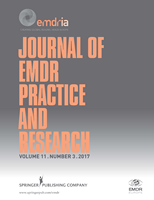
Crucial Processes in EMDR
More Than Imaginal Exposure
The processes that underlie the effectiveness of eye movement desensitization and reprocessing (EMDR) are examined by evaluating the procedural differences between it and exposure therapy. Major factors include the degree of emphasis placed on reliving versus distancing in the therapies
and the degree to which clients are encouraged to focus on direct trauma experiences versus experiences associated with the trauma. Research results indicate that, unlike traditional imaginal exposure, reliving responses in EMDR did not correlate with symptom improvement. Instead, consistent
with an information processing model, the degree of distancing in EMDR was significantly associated with improvement. A case study is described to highlight these methodological divergences in the respective therapies relating to reliving. Finally, the research regarding the possible sources
of the distancing response within EMDR was examined. The results indicate that the distancing process was more likely to be an effect produced by eye movements than by any therapist instructions. Theoretical and research evaluations indicate that the mechanisms underlying EMDR and traditional
exposure therapy are different.
Keywords: EMDR; EXPOSURE THERAPY; INFORMATION PROCESSING; PTSD; RELIVING
Document Type: Review Article
Publication date: 01 November 2008
- The Journal of EMDR Practice and Research is no longer available to subscribers on Ingenta Connect. Please go to http://connect.springerpub.com/content/sgremdr to access your online subscription to Journal of EMDR Practice and Research.
- Access Key
- Free content
- Partial Free content
- New content
- Open access content
- Partial Open access content
- Subscribed content
- Partial Subscribed content
- Free trial content